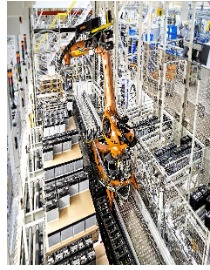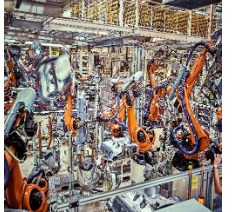Robotics and artificial intelligence are terms that are more and more common, so it is surprising that humanity has not yet arrived at a single definition of what a robot actually is. “I think of industrial robots, which are my daily bread. Because the word robot is a bit like the word sweet – we all know what it is, but if each of us were to write our own definition, the definitions wouldn’t be exactly the same,” says Jan Čejka from Škoda’s welding and electrical equipment planning team, who will be Škoda Storyboard’s guide to the world of robotics.

It is not much of an exaggeration to describe these machines as superheroes. They can work non-stop, they don’t get tired and they have superhuman abilities: they can easily handle loads as heavy as half a tonne. They are also far more precise than humans. They can make linear movements in a straight line with incomparably greater precision and certainty than the most skilled surgeon. Last but not least, robots are great mathematicians: in an instant they can recalculate all sorts of spatial coordinates, shift coordinate systems, adjust the trajectory of the arm and precisely grasp the required object.

“I like to say that robotics is the king of engineering. It combines all the modern scientific and technical disciplines – mathematics, physics, programming, engineering and design, sensors, materials engineering or electrical engineering. Are you interested in engines? Do you program? In robotics, you will find pretty much everything that can be studied in engineering schools today. In addition, research results can be applied in this field, whether that is research in mathematics, artificial intelligence or new materials – all of which can be used in the design of arms, gearboxes or the development of lubricants,” Čejka says

robotics expert
Welding without human intervention
More than 4,000 robots work at Škoda. Welding, handling and gluing are the most automated processes, accounting for around 85 per cent of robot activities. The remaining fifteen per cent of the technologies that robots control comprise activities such as clinching, flanging, brushing or laser soldering.
“Robotics is more complex in the places where a new part is being added to the line and in the finishing area. That is therefore where we are trying to apply collaborative robots. Increasingly, we are also working with what are known as vision systems, which are gradually automating the input – the robot can select the right part from the pallet and grab it itself,” says the expert.

It follows that robotisation makes the most sense for routine and, above all, physically demanding activities. The aim, of course, is not to put people out of work, but to make it easier. Humans are irreplaceable for a large part of the work: they make quick decisions, have fine and precise motor skills, and can think. And anyway, someone has to take care of the robots, keep them running, repair them, and program them.
“We can say that our robots work in a swarm in the welding shop. The robots communicate with each other and graciously give each other right of way if they are in danger of colliding. It could also happen that a robot flies over your head. Škoda has been testing autonomous drones in logistics. Machines and manipulators to improve work ergonomics are also common in assembly. Collaborative robots that share a workspace with a human and are not separated by any mechanical barrier could also fall into this category. Robots like this help us perform glueing or measure the dimensions of parts,” concludes Čejka.







